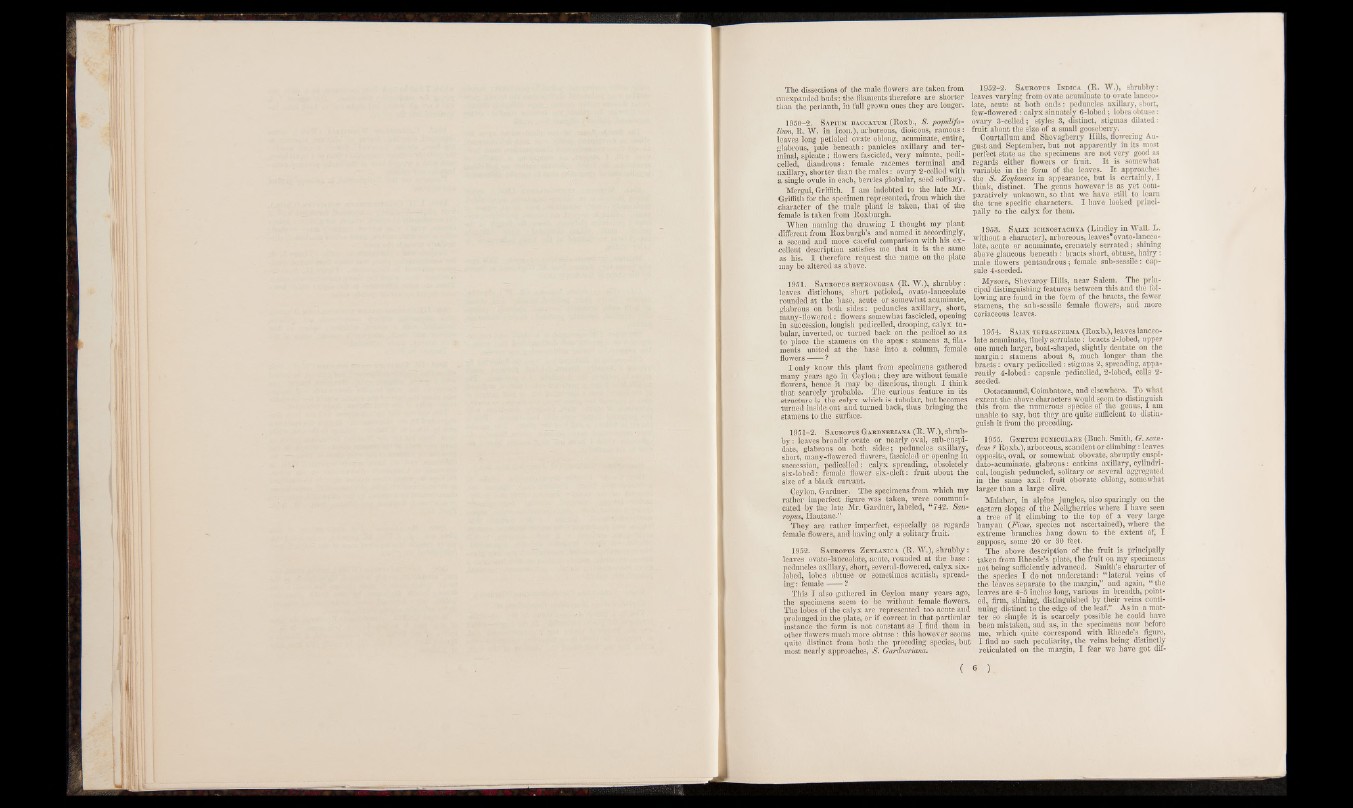
The dissections of the male flowers are taken from
nnexpanded buds : the filaments therefore are shorter
than the perianth, in full grown ones they are longer.
1950-2. Sapiom baccatum (Roxb., S. popidifo-
lium, R. W. in Icon.), arboreous, dioicous, ramous :
leaves long petioled ovate oblong, acuminate, entire,
glabrous, pale beneath: panicles axillary and terminal,
spieate ; flowers fascicled, very minute, pedi-
celled, diandrous : female racemes terminal and
axillary, shorter than the males : ovary 2-celled with
a single ovule in each, berries globular, seed solitary.
Mergui, Griffith. I am indebted to the late Mr.
Griffith for the specimen represented, from which the
character of the male plant is taken, that of the
female is taken from Roxburgh.
When naming the drawing I thought my plant
different from Roxburgh’s and named it accordingly,
a second and more careful comparison with his excellent
description satisfies m e'th at it is the same
as his. I therefore request the name on the plate
may be altered as above.
1952-2. Satjbopos Indica (R. W.), shrubby:
leaves varying from ovate acuminate to ovate lanceolate,
acute at both ends: peduncles axillary, short,
few-flowered: calyx sinuately 6-lobed; lobes obtuse:
ovary 3-celled; styles 3, distinct, stigmas dilated:
fruit about the size of a small gooseberry.
Courtallum and Shevagherry Hills, flowering August
and September, but not apparently in its most
perfect state as the specimens are not very good as
regards either flowers or fruit. I t is somewhat
variable in the form of the leaves. I t approaches
the S. Zeylanica in appearance, but is certainly, I
think, distinct. The genus however is as yet comparatively
unknown, so that we have still to leani
the true specific characters. I have looked principally
to the calyx for them.
1953. S^Lix ichnostachya (Lindley in Wall. L.
without a character), arboreous, leaves" ovato-lanceo-
late, acute or acuminate, crenately serrated; shining
above glaucous beneath: bracts short, obtuse, h airy :
male flowers pentandrous; female sub-sessile: capsule
4-seeded.
1951. Satjropus retrovers a (R. W.), shrubby:
leaves distichous, short petioled, ovato-lanceolate
rounded at the base, acute or somewhat acuminate,
glabrous on both sides: peduncles axillary, short,
many-flowered: flowers somewhat fascicled, opening
in succession, longish pedicelled, drooping, calyx tubular,
inverted, or turned back on the pedicel so as
to place the stamens on the ap e x : stamens 3, filaments
united a t th e ' base into a column, female
flowers----- -? .
I only know this plant from specimens gathered
many years ago in Ceylon; they are without female
flowers, hence it may be diaacious, though I think
that scarcely probable. The curious feature in its
structure is the calyx which is tubular, but becomes
turned inside out and turned back, thus bringing the
stamens to the surface.
1951-2. Sauroptjs Gardneriana (R. W.), shrubby
: leaves broadly ovate or nearly oval, sub-cuspidate,
glabrous on both sides; peduncles axillary,
short, many-flowered flowers, fascicled or opening in
succession, pedicelled: calyx spreading, obsoletely
six-lobed: female flower six-cleft: fruit about the
size of a black currant.
Ceylon, Gardner. The specimens from which my
rather imperfect figure was taken, were communicated
by the late Mr. Gardner, labeled, “ 742.5cm-
ropus, Hautane.”
They are rather imperfect, especially as regards
female flowers, and having only a solitary fruit.'
1952. Satjropus Zeylanica (R. W.), shrubby:
leaves ovato-lanceolate, acute, rounded at the base :
peduncles axillary, short, several-flowered, calyx six-
lobed, lobes obtuse or sometimes acutish, spreading:'
female — - ?
This I also gathered in Ceylon many years ago,
the specimens seem to be without female flowers.
The lobes of the calyx are represented too acute and
prolonged in the plate, or if correct in that particular
instance the form is not constant as I find them in
other flowers much more obtuse: this however seems
quite distinct from both the preceding species, but
most nearly approaches, 5. Gardneriana.
Mysore, Shevaroy Hills, near Salem. The principal
distinguishing features between this and the following
are found in the form of the bracts, the fewer
stamens, the sub-sessile female flowers, and more
coriaceous leaves.
1954. Salix tetrasperma (Roxb.), leaves lanceolate
acuminate, finely serrulate: bracts 2-lobed, upper
one much larger, boat-shaped, slightly dentate on the
margin: stamens about 8, much longer than the
bra cts: ovary pedicelled: stigmas 2, spreading, apparently
4-lobed: capsule pedicelled, 2-lobed, cells 2-
seeded.
Ootacamund, Coimbatore, and elsewhere. _ To what
extent the above characters would seem to distinguish
this from the numerous species of the genus, I am
unable to say, but they are quite sufficient to distinguish
it from the preceding.
1955. Gnettjm ptjniculare (Buch. Smith, G. scan-
dens ? Roxb.), arboreous, scandent or climbing: leaves
opposite, oval, or somewhat obovate, abruptly cuspi-
dato-acuminate, glabrous: catkins axillary, cylindrical,
longish peduncled, solitary or several aggregated
in the same axil: fruit obovate oblong, somewhat
larger than a large olive.
Malabar, in alpine jungles, also sparingly on the
eastern slopes of the Neilgherries where I have seen
a tree of it climbing to the top of a very large
banyan (Ficus, species not ascertained), where the
extreme branches hang down to the extent of, I
suppose, some 20 or 30 feet.
The above description of the fruit is principally
taken from Rheede’s plate, the fruit on my specimens
not being sufficiently advanced. Smith’s character of
the species I do not understand: “ lateral veins of
the leaves separate to the margin,” and again, “ the
leaves are 4-5 inches long, various in breadth, pointed,
firm, shining, distinguished by their veins continuing
distinct to the edge of the leaf.” As in a m atter
so simple it is scarcely possible he could have
been mistaken, and as, in the specimens now before
me, which quite correspond with Rheede’s figure,
I find no such peculiarity, the veins being distinctly
reticulated on the margin, I fear we have got dif